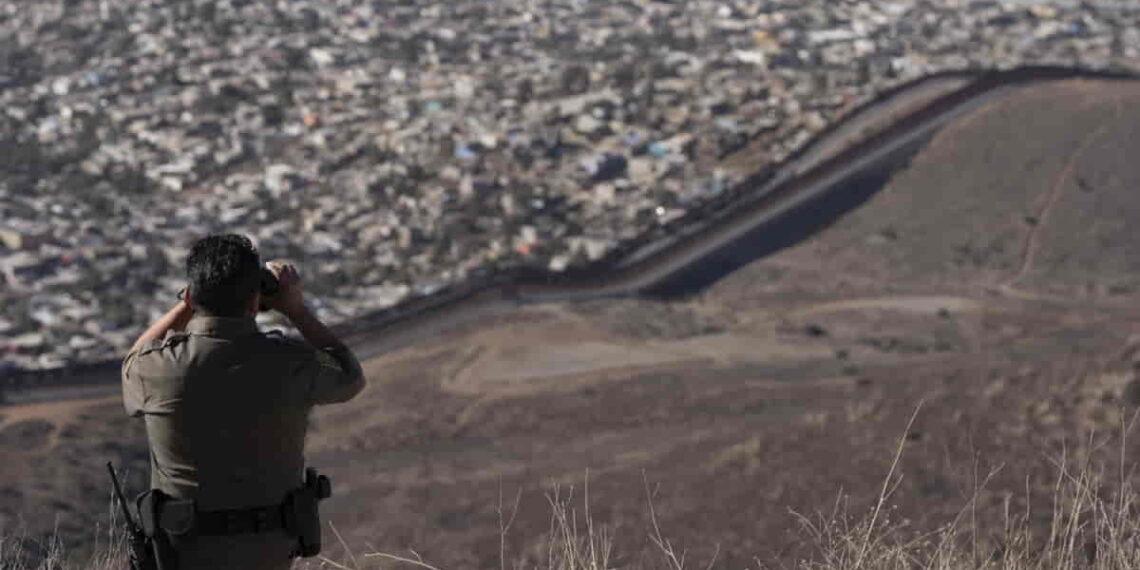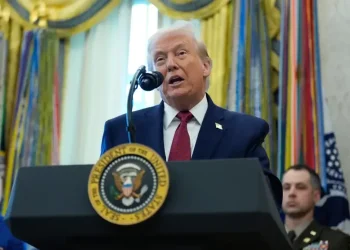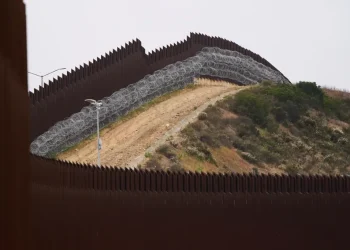Trump Declares Border Emergency Amid Calm After Years of Crisis
President Donald Trump’s recent declaration of a border emergency marks a significant shift as the situation at the U.S.-Mexico border has entered a phase of relative calm, following years of turmoil. Once the largest destination for asylum-seekers, the border crisis has seen a dramatic drop in illegal crossings and arrests, leading to a change in how the Border Patrol operates.
A Shift in Border Patrol Activity
As Border Patrol agents monitor vast stretches of land, the once-frequent radio chatter is now filled with long periods of silence, broken only by updates tracking single migrants. One agent remarks, “There’s a pair way down there. We’ll see if they start moving up,” reflecting the quieter conditions at the border.
Trump’s emergency declaration, made in response to what he called “America’s sovereignty under attack,” comes at a time when arrests for illegal border crossings have dropped dramatically. Arrests fell by over 80% in December, from an all-time high of 250,000 the previous year to about 47,000. The decrease followed stronger enforcement measures by Mexican authorities and the implementation of stricter asylum policies under President Joe Biden.
Trump’s Critique of Biden’s Border Measures
Despite this drop in arrests, Trump believes Biden’s actions haven’t gone far enough. Under Biden, border arrests hit 4 1/2-year lows, but were still significantly higher than during Trump’s early years in office. Trump highlighted the increased arrests of migrants compared to 2017, a low point he used to emphasize his stance on border control during his campaign rallies.
A Glimpse of Daily Border Patrol Operations
On a recent ride-along with Border Patrol in San Diego, the busiest sector for illegal crossings, the situation seemed more controlled. For six hours, the AP team encountered no migrants until the final moments, when three Chinese nationals and one Malaysian crossed through a gap in the border wall. These individuals were taken into custody and processed in large tents set up during Biden’s presidency.
While some migrants continue to cross, the logistics of deporting them to countries like Venezuela, Nicaragua, and Cuba, which are reluctant to accept their citizens, remains a significant challenge. This complicates Trump’s border plans, which hinge on effectively detaining and transporting migrants.
A Return to Traditional Border Patrol Duties
Under Biden, Border Patrol agents had been tasked with processing and releasing asylum-seekers with notices to appear in immigration court. However, recent changes have shifted their focus back to traditional duties, including tracking individuals and small groups trying to evade capture.
The number of migrants released into the U.S. has dropped sharply, with fewer than 7,000 released in December 2023, a 96% decrease from nearly 192,000 a year earlier. In the third week of January 2024, El Paso reported only 211 releases, a stark contrast to the tens of thousands released each week under Biden.
Shifting Border Conditions in San Diego
In San Diego, Border Patrol agents monitor dangerous mountain trails with expansive views of Tijuana, Mexico. Migrants who evade capture often walk for up to two days through the wilderness before reaching smugglers’ vehicles. Agents track their movements and plan when to move in, using surveillance to stay ahead of the border crossers.
Just a year ago, Border Patrol agents were overwhelmed by large groups of asylum-seekers, many of whom waited for days in extreme temperatures. Volunteers assisted these migrants by passing food and medical supplies through gaps in the border walls. However, by early January 2024, migrant groups had shrunk to small numbers, with occasional larger groups of around 40 individuals.
Karen Parker, a volunteer providing medical assistance to migrants in remote areas, said she once encountered hundreds of people crossing nightly. By January, she noticed a decrease in the number of crossings, attributing the slowdown to factors such as freezing temperatures and wildfires.
Trump’s Emergency Powers and Future Plans
Trump’s border emergency declaration will rely heavily on funding for detention and transportation, as well as negotiations with countries that refuse to accept their citizens. During his first term, Trump used emergency powers to divert billions of dollars from the Defense Department to fund the border wall. He reiterated his commitment to securing the southern border, saying, “It is my responsibility as President to ensure that the illegal entry of aliens into the United States via the southern border be immediately and entirely stopped.”
Local Impacts: Shelter Closures in Arizona
The effects of Trump’s border policies are being felt on the ground. In Arizona, Pima County announced the closure of two migrant shelters in Tucson due to a halt in migrant releases. Since 2019, these shelters have served over 518,000 migrants. Similarly, Jewish Family Service of San Diego reported that it hadn’t received any migrants since the Trump administration ended the use of the CBP One app, which allowed migrants to legally enter the U.S. for processing.
Conclusion
Trump’s border emergency declaration signals a major shift in U.S. immigration policy. While border arrests have fallen significantly, the complexity of deportations, smuggling activities, and the humanitarian challenges at the border continue to complicate enforcement. As the situation evolves, it remains to be seen how Trump’s emergency powers and policies will reshape the future of U.S. border control.
This article was rewritten by JournosNews.com based on verified reporting from trusted sources. The content has been independently reviewed, fact-checked, and edited for accuracy, neutrality, tone, and global readability in accordance with Google News and AdSense standards.
All opinions, quotes, or statements from contributors, experts, or sourced organizations do not necessarily reflect the views of JournosNews.com. JournosNews.com maintains full editorial independence from any external funders, sponsors, or organizations.
Stay informed with JournosNews.com — your trusted source for verified global reporting and in-depth analysis. Follow us on Google News, BlueSky, and X for real-time updates.














